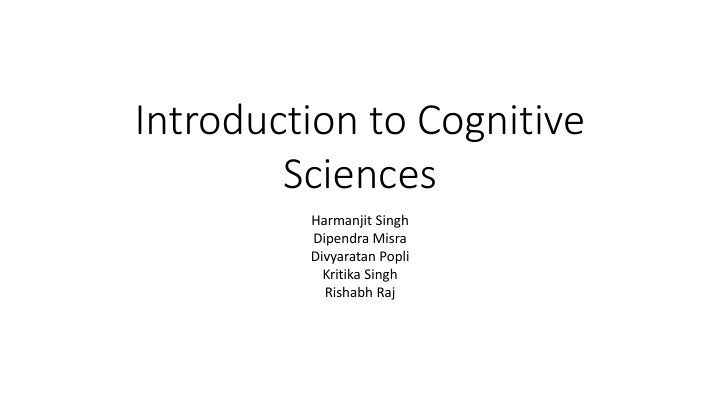



Introduction to Cognitive Sciences Harmanjit Singh Dipendra Misra Divyaratan Popli Kritika Singh Rishabh Raj
Thoughts on Chinese room Argument • If computers are not given some basic symbol grounding they will understand the Chinese precisely the way person in the Chinese room does. • However, if some symbol grounding is provided to the computer; it will start thinking in same terms as native Chinese do. • But first what are we trying to achieve. • What is meant by thinking?
Views on Searle’s Arguments • Strong AI claims that thinking is manipulation of formal symbols. • The person in the Chinese room does not understand the symbols and hence, does not think like a Chinese person would do. • Searle claims that computers too just manipulate symbols like the person in the Chinese room and hence cannot think. • We don’t think it is complete. If in addition to the rules, rulebook also uses images that link the symbols with their meanings, the person is capable of thinking by mere symbol manipulation. • Similarly, if a computer program can “see”(image processing) and “point”(robotic manipulation), it can attach meanings to symbols.
Searle’s Epiphenomenal Notion • If the person inside the room can solve this problem using some rules • Then he can relate the words with the images and thus he has grounded his otherwise meaningless symbols • This grounding may be wrong but it will no longer be meaningless • With passage of time he will be able to relate words to sound, images and other senses • A person only getting the Chinese symbols will not understand Chinese unless it is grounded in his first language or in real life experiences.
Searle’s Epiphenomenal Notion • Searle assumes that thinking is special to biological organs on account of ‘casual properties’ • Once we assume this then clearly one cannot duplicate the result on silica. The entire debate becomes meaningless • Thus to him mental thinking is an epiphenomenal notion • We consider the other person to be thinking on the basis of his reaction to our queries [Turing Test] • Why not give the same luxury to machines
What if some symbols in computers are grounded? Neural network • They trained three-layer feed-forward networks to sort lines into categories according to their length • CP is defined as a decrease in within-category inter-stimulus distances and an increase in between-category distances, • Such networks not only exhibit successful categorization, which – as we said – is a relatively easy task for neural networks, but they also exhibit the same natural side-effect revealed by human categorization, i.e., Categorization Perception (CP). In other words, within-category compression and between-categories expansion can be observed both in humans and networks. 1 Harnad, Hanson and Lubin (1991, 1995)
References • Syntactic semantics: Foundation of Computational Natural Language Understanding by William J Rapaport. • Angelo Cangelosi, Alberto Greco and Stevan Harnad; Symbol Grounding and the Symbolic Theft Hypothesis; In Cangelosi A & Parisi D (Eds) (2002). Simulating the Evolution of Language. London: Springer • Harnad, S.; The Symbol Grounding Problem; (1990); Physica D 42: 335-346 . • Saussure, Ferdinand de; Nature of the Linguistics Sign; In Charles Bally & Albert Sechehaye (Ed.)(1916), Cours de linguistique générale, McGraw Hill Education. ISBN 0-07-016524-6. This document also contains: Charles Sanders Peirce, 1932: The sign: icon, index, and symbol (excerpt). • John R. Searle; Is the Brain's Mind a Computer Program?; In Scientific American, January 1990, pp. 26--31 .
Recommend
More recommend